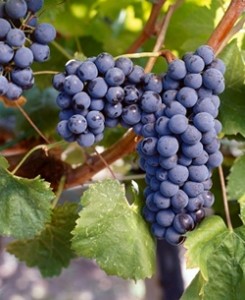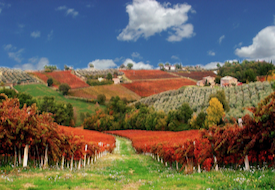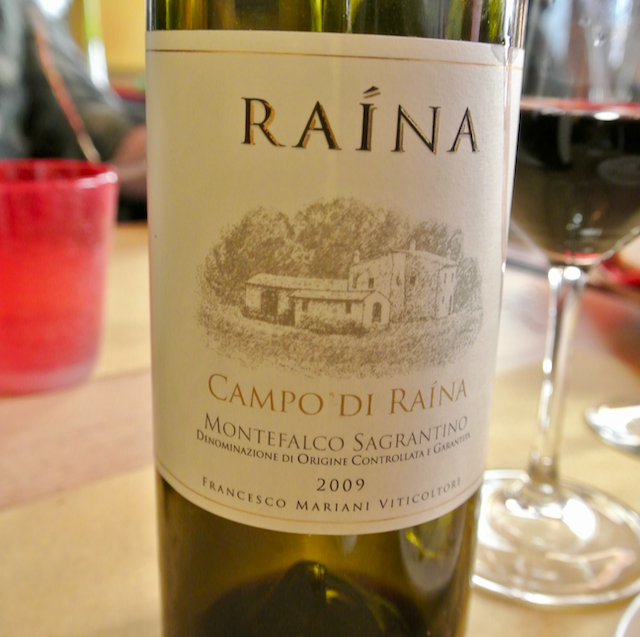
Sagrantino Grapes in Umbria
If many wine publications are to be believed, Sagrantino is “probably Italy’s most tannic red wine.” This is a heavy burden for any varietal to bear. We find Sagrantino to be one of Italy’s most nuanced, while undeniably intense, wine grapes with chewy but well-polished tannins and gorgeous red and black fruit flavors.
Sagrantino, like many native Italian grapes, has an uncertain history. It’s important to consider that the large chunk of history (roughly 1,000 years) between the fall of the Roman Empire and the Renaissance was a period of lost history. From what we do know, Sagrantino appears to be a grape with an ancient history.
There are written accounts of the grape we now call Sagrantino from the Middle Ages, while the name Sagrantino seems to have first appeared in 1598. It is nearly certain that from the 16th century through much of the 20th century, Sagrantino was used to create sweet wines. These wines were made with the appassimento technique, utilizing partially dried grapes to create a rich and complex wine. When the DOC that features Sagrantino was created in 1977, it was for sweet wine, not dry red.

Vineyard near Montefalco
Sagrantino is a native of Italy’s Umbria region – a land-locked region in Central Italy that’s bordered by Tuscany, Lazio, and Le Marche. More than 90% of all Sagrantino grown in Italy is grown in Umbria.
Sagrantino features in one appellation, Montefalco Sagrantino DOCG. Sagrantino is the solo grape utilized to create this dense, complex, and age-worthy wine. This appellation was formerly part of the Montefalco DOC and was awarded its own designation in 1992. It was named Sagrantino di Montefalco, later becoming Montefalco Sagrantino in 2009. Sagrantino plays a supporting role in the wines of Montefalco Rosso DOC, blending with Sangiovese in quantities of no less than 10% and no more than 25%.
Like many Italian varietals, Sagrantino was in danger of extinction. Arnaldo Caprai is often credited with reviving this grape. Caprai bought his estate in 1971 and planted 13.5 acres of Sagrantino in 1973. His wines are believed by many to be the gold standard of Sagrantino in Umbria.
Sagrantino has quite high polyphenol levels that contribute to its wines’ dark color and dense tannins. Sagrantino wines are described as abundant in aromas and flavors: red berries, red and black cherry, ginger, anise, cocoa, vanilla, and brown baking spices. The famous tannins are surely plentiful but present themselves as well-polished and rarely astringent.

Bottle of Montefalco Sagrantino
In the case of Montefalco Sagrantino DOCG, it is required to be aged a minimum of 37 months, including a minimum of 12 months in barrel. Many producers greatly exceed this 12-month minimum in wood. This is a deep and complex wine that will begin to show its full potential five years after its vintage, and in favorable vintages, it can age for decades.
If you have never experienced Sagrantino I suggest trying a bottle or two of Montefalco Rosso to subtly introduce your palate to the complex and rustic flavors Sagrantino offers. If you find these wines enjoyable, then step up to Montefalco Sagrantino.
Montefalco Sagrantino needs to breathe, so we urge you to decant the wine at least 30 minutes before serving. This bold food wine pairs well with cured sausages, game, braised meats, and aged pecorino cheese.

One of the most nuanced, and relatively undiscovered, reds in Italy. Not much of it in the New World, but I brought it to Raffaldini Vineyards in North Carolina’s Swan Creek AVA and it has excelled.
I would love to try a New World version of Sagrantino. I’ll look for this when I’m in North Carolina.
Sean – it’s also thriving in California! Check out DaVero in Healdsburg (Sonoma County). They do an amazing job with Italian varieties, including a Sagrantino that turns heads! A great way to get acquainted is through the newly launched Virtual Tasting kit offered (affordable AND a stellar line-up of wine including Sagrantino). The juice is delish!!
Great news. We would certainly encourage DaVero to send us some Sagrantino so we can share it with our readers.
We at Denier-Handal Vineyards have been growing and making dense, dark and delicious Sagrantino wine grown in the Dry Creek Valley, Healdsburg, Sonoma County California successfully for quite some time.